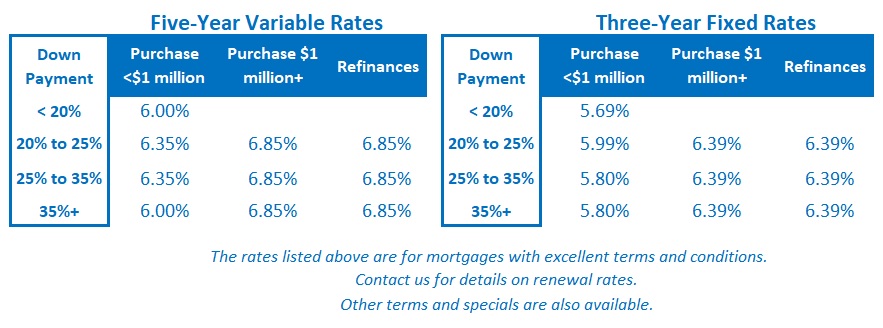US Inflation Rises Ahead of the Federal Reserve’s Meeting This Week
September 18, 2023Thoughts on Diverging US/CDN Economic Momentum, the Mortgage Stress Test, and an Unfair Policy Trapping Many Mortgage Borrowers
October 3, 2023
There was a lot of mortgage-related news last week.
On Tuesday we received the latest inflation data from Statistics Canada. It confirmed that prices surged higher again in August.
On Wednesday, the US Federal Reserve held its policy rate steady but roiled markets with hawkish policy-rate language and projections of tighter monetary policy ahead. Investors on both sides of the 49th parallel responded by ratcheting up bond yields to price in higher-for-longer inflation.
On Friday, some lenders responded by announcing another round of increases to their fixed mortgage rates. Others will probably follow early this week.
Here are my five key takeaways from last week:
- Economic growth is now cooling, but inflation is still heating up.
Our headline Consumer Price Index (CPI) increased from 3.3% in July to 4.0% in August on an annualized basis, higher than the consensus forecast of 3.8%. The Bank of Canada’s (BoC) two key measures of core inflation, CPI-trim and CPI-median, also increased to 3.9% and 4.1% respectively.
Last month’s price spike was primarily attributed to higher gas and shelter costs and less favourable base effects (which I wrote about in detail in this recent post). But it is also important to note that price pressures remain broadly based, as the increases in the core measures attest.
Scotiabank economist Derek Holt observed that about half of the CPI basket increased by 4% on a seasonally adjusted annualized basis, while a full two thirds of the CPI basket increased by 3% when measured the same way.
We have now entered a period of some turmoil in our economic cycle. Rate hikes have increased their bite, and our economic momentum is slowing, but inflation is not following suit.
Many market watchers have assumed that our economy and inflation would slow alongside each other. But our latest inflation data are a reminder that waning economic momentum is a necessary but not sufficient condition for returning inflation to its 2% target.
For now, growth and inflation are headed in opposite directions.
- The BoC’s meeting minutes reveal that it was closer to hiking than was widely believed.
The consensus take on the BoC’s September 6th decision to hold its policy rate steady was that its hawkish accompanying commentary was designed just to ensure that consumers didn’t over-react to its decision – as they did when the Bank formally paused in January.
But the BoC’s meeting minutes, released last week, confirmed that the Bank was closer to another hike than most believed. And that was before it received the most recent inflation data.
The minutes confirmed that the Bank was confident that the rate hikes were gaining traction and slowing demand, but also that the Bank was still concerned that core inflation measures were “stubbornly persistent”.
The council’s members also emphasized the urgency to staunch inflation’s resurgence before inflation expectations become further unanchored, thereby fostering conditions that would require more hikes later.
On that note …
- Higher labour costs continue to be baked in.
Last week, Ford Canada agreed to union wage increases of 15% over the next three years, plus some additional perks.
That agreement will not only serve as the basis for talks with the other two of the Big Three car manufacturers (GM and Chrysler) but will also serve as a guideline for setting wage increases across a broad range of other businesses and industries.
My point here is not that unionized workers don’t deserve pay increases. In most cases, they are just playing catch-up after an extended period of rampant inflation. My point is just that these higher labour costs are being baked into future goods prices, making future inflation stickier.
Annual wage increases in the 5% range are a real-world example of what happens when inflation expectation is unanchored from the BoC’s 2% target.
- The bond market is now skittish about where the BoC’s policy rate is headed.
There is always a lot of market volatility at turning points in the economic cycle, and the bond futures market is no exception.
Earlier this month, investors were pricing in 90% odds of another BoC increase in 2023. Then we received the disappointing GDP data, and those odds bottomed out at about 10%. After last week’s inflation data, the bond market is now assigning 40% odds that the Bank will hike again this year.
Another quarter-point hike will have only a small incremental impact on borrowing costs but would be more important in another way.
Historically, there has been about a ten-month gap between the Bank’s last hike and its first cut.
That well-established pattern will likely cause the consensus to push its rate-cut bets further out if another hike materializes. (In practical terms, that would mean higher GoC bond yields with the likelihood that our fixed mortgage rates would follow.)
- The US Federal Reserve has made a similar assessment of US inflation.
Last week the Fed held its policy rate steady, as expected, but also surprised financial markets by offering a very hawkish rate forecast.
It now projects one more hike this year and only two cuts in 2024, instead of the four previously anticipated. The Fed is also now forecasting that it will take until 2026 for inflation to fall back to its 2% target.
Bond market investors responded by paring back their bets on Fed rate cuts next year and by driving up bond yields to price in a higher-for-longer view.
Rising US Treasury yields, as usual, took their Canadian equivalents along for the ride, contributing to the fixed-mortgage-rate increases that we saw at the end of last week.
Here is my assessment of the current options available to Canadian mortgage borrowers:
If, and only if, you can tolerate the risk that variable mortgage rates may go higher from here and remain at elevated levels for another year or more, choosing a five-year variable rate today has the greatest potential for saving over the full term of your mortgage.
When the BoC finally starts cutting its policy rate, variable-rate borrowers will benefit immediately. I continue to believe that the higher the policy rate goes, the more it will drop when inflation is finally contained.
If you prefer the peace of mind that fixed mortgage rates offer, like most of the borrowers I work with today, I think a three-year term offers the best risk/reward balance among today’s fixed-rate options.
Three-year fixed rates come with a premium of about .50% over current five-year fixed rates. But I would be reluctant to lock in for longer than three years when rates are at their highest levels in more than a decade and appear to be near their peak.
Alternatively, one- or two-year fixed rates are now about 1% higher than today’s lowest fixed rates, and the shorter the term, the greater the risk that you’ll be renewing before the BoC has won its inflation fight. The Bottom Line: GoC bond yields surged higher last week, and fixed mortgage rates have resumed their upward march. Some lenders raised on Friday, and others will likely follow in short order.
The Bottom Line: GoC bond yields surged higher last week, and fixed mortgage rates have resumed their upward march. Some lenders raised on Friday, and others will likely follow in short order.
Variable-rate discounts were unchanged last week.
Variable-rate borrowers should be prepared for another BoC rate hike at its next meeting on October 25, barring a downward inflation surprise (which seems increasingly unlikely, considering the points I have outlined above).







